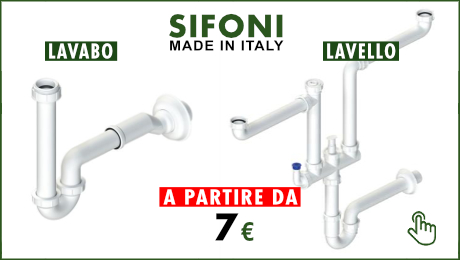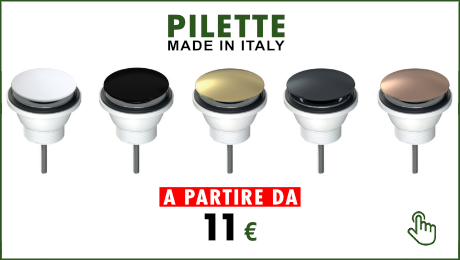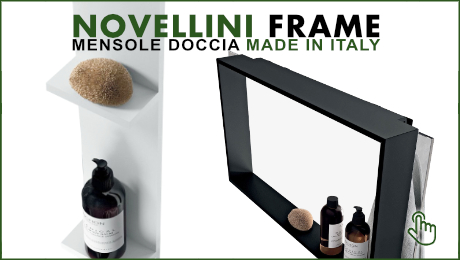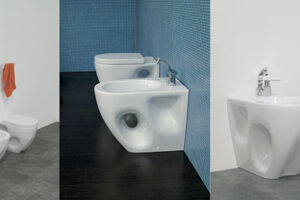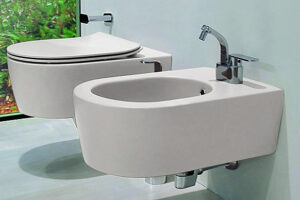Let’s start talking about this ceramic company from its origins and its founder: Dr Potito Randi. From the site dedicated to him for the centenary [ Clik HERE ]
let us take an interesting passage from the historical account: Dr. Potito Randi, who was already the owner of the SPICA factory in Castelli, where tableware was produced, and of the SPICA Ceramics Plant in Teramo, where glazed majolica wall tiles were produced at the time, both single-colour and decorated, had realised that it was necessary to complement this production with other products to complete the range demanded by the market.
In particular, it was necessary to combine wall tiles with a series of sanitary ware and porcelain stoneware floor tiles for industrial use.
Having obtained a 130,000 square metre plot of land from the municipality of Teramo in the S. Atto area, which was destined to become the centre of Teramo’s industrialisation nucleus, it was possible to build the SPEA plant.
Right from the start, in 1965, the plant consisted of two independent production sectors separated by one large centralised warehouse.
The sector to the east was set up for the production of different series of bathroom articles made from the ‘vitreous-china’ mixture, each consisting of a washbasin, toilet bowl, bidet, pedestal and toilet cistern, which differed in their architecture and appearance while still complying with functionality and complying with current regulations.
To the bathroom articles, ‘accessories’ (soap dishes, towel racks and shelves) were also added, and later an exclusive range of furniture articles was introduced.
The sector also included a modelling department (for the production of prototypes) and a department for the construction of the plaster moulds required for production.
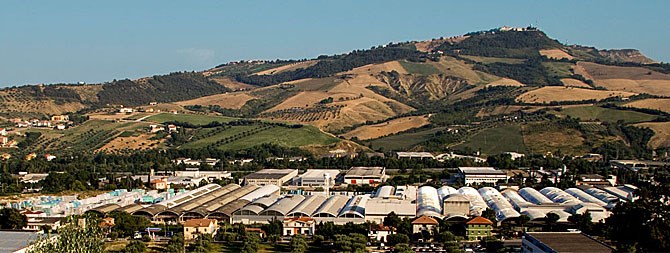
In addition to the basic white glaze, a range of coloured glazes with shades to match those of the tiles produced in the Teramo factory was also introduced for the most prestigious series.
All production was fired at a temperature of 1220° centigrade using one of the most modern tunnel kilns in existence.
The sector to the west was set up for the production of porcelain ceramic floor tiles (a highly wear-resistant product mainly used in industrial warehouses and flooring exposed to the weather).
In this sector, a tunnel kiln (self-built) was built in the first phase, which was joined by a second twin kiln a few years later. The market demanded that the range of bathroom articles also included shower trays, sinks and washbasins. These latter articles. being of large dimensions could not be made with the vitreous-china mixture but a less glassy ‘fire-clay’ mixture had to be used, which was better suited to avoid deformations during firing.
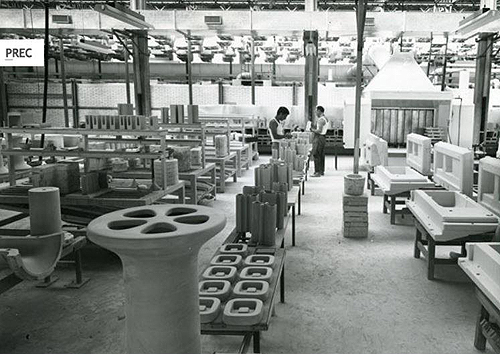
Therefore a new hall was built in the west sector in which production of this new range could begin. One of the two existing tunnel kilns was used for firing the ‘fire-clay’.
The entire production was realised by optimising the flows within the factory, which also ensured flexibility in the case of the introduction of new articles.
A special feature of SPEA’s production of sanitary appliances was that the colours applied to the most valuable series were exclusive (i.e. different from those of other manufacturers, both Italian and European) and with the range of ‘two-tone’ (i.e. the application of two different coloured enamels in the same piece) the market gradually became more interesting.
This made it easier for wholesalers to purchase in a single order both sanitary ware and coloured bathtubs, which SPEA marketed by sourcing from manufacturers specialising in the sector. In this way, buyers could obtain from the SPICA/SPEA group a complete range of articles required for both residential and industrial building. During the years 1969-1971, the ceramic sanitary ware production of the various European factories was gradually brought into line with new standards in terms of both physical-chemical and dimensional characteristics and the range of colours applied.
Even though the chemical-physical and dimensional characteristics corresponded to these new standards, the importance for SPEA to have exclusive colours was diminished. As a result, it became increasingly difficult for SPEA to source coloured bathtubs for marketing at optimum cost. As a result, wholesalers found it more convenient to purchase coloured bath fittings from companies that had quickly adapted to the new standards, mainly because of the ease of matching the baths, which the few existing manufacturers were placing on the market at favourable prices.
It should be mentioned that the higher added value of ‘coloured’ could not be neglected, so it was not possible for SPEA to produce only white articles in order to remain competitive.
When SPEA was sold to the Villeroy & Boch group in 1971, the first task of the buyer was to immediately bring all the factory’s product characteristics into line with European standards.
Sales improved dramatically as a result, and in order to increase production of both “sanitary ware and “porcelain stoneware” Villeroy & Boch authorised massive investment in new plants and introduced maximum mechanisation of the production process.”
All ceramic series released under the SPEA ceramics brand and their toilet covers are now out of production and considered old models. We selected a number of toilet seat manufacturers that could best reproduce the old toilet seats because there was a strong demand from the market given the success that many of the ceramics produced in these factories had achieved.
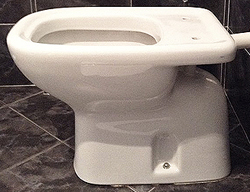
SELECTA series by Hatria Spea
A toilet with a rectangular shape and, above all, with a step in the upper surface that leads to the toilet cover needing shaped bumpers. We have seen ceramic series of this type in the post: ”Sanitary ware with an inclined plane and their toilet covers with shaped bumpers (part 1)” where we have also seen: SINTESI by Cesame, CLODIA by Dolomite and ASTRO by Eos. The toilet seat covers for all these sanitary fixtures have to be made almost to measure because the bumpers have to be positioned exactly in the joint of the toilet step to give maximum stability and durability. As customers who have this type of sanitary ware in their bathrooms are well aware, if you do not fit a toilet seat with inclined bumpers that are positioned exactly in the step plane, it will never stay put and the durability will be limited. We have selected a model that has stainless steel hinges in addition to the inclined/rising bumpers. Long live the toilet seat! You can find it at the following link [ clik HERE ]
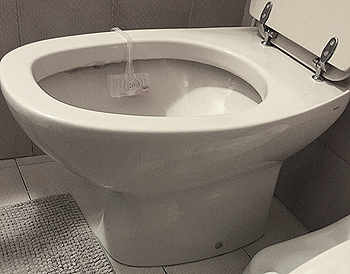
GRAN SASSO series by Spea
Sanitary ware and large toilet seat covers. In the post: ”Large sanitaryware (old models) and their unobtainable toilet covers” we saw how at the turn of the 1970s and 1980s ceramic companies began to offer larger WCs and bidets than the previous standard. As a consequence of this growth, toilet seats also increased in size and in order to fit on these sanitary ware fixtures they must have precise and correct dimensions. Looking for a replacement in shopping centres and DIY stores, one quickly realises that the standard and universal seats currently on the market are unbelievably small and out of proportion for sanitary ware of that size. Toilet seats measuring 50, 51, 52 cm and perhaps 53 cm in length can hardly be considered a standard size. The legendary series such as ITALICA by Pozzi Ginori, LAGO by Ceramica Dolomite and AMICA by Globo Ceramiche. This Gran Sasso sanitary ware was produced not only in white but also in champagne, mink and fern green. You can find all its WC covers in the Sintesibagno store at the following link [ clik HERE ]
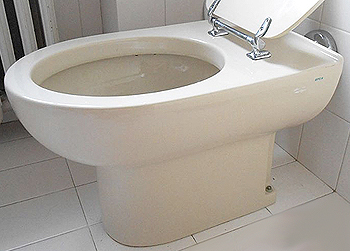
LARA series by Spea
One of the best-selling series of the 1980s. Clean and sophisticated lines. To improve the aesthetics even of the lower part of the sanitary ware (foot) the company brought the fixing holes in the back (an idea later taken up by other competitor companies). The toilet seat covers for this Spea sanitaryware (Lara) can be found in the store at the following link [ clik HERE ]
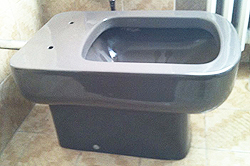
EDOS series by Spea
Throughout the history of bathroom design, many ceramic companies have ventured into the production of rectangular shaped sanitary ware. Most of these series are now out of production and finding a toilet seat cover is often very difficult. In previous posts we have already looked at WCs of this type and suggested the link where you can find their toilet seat. In the post: ”Rectangular toilet seats. Why do all toilet seat covers for this toilet look the same?” we have seen: CONCA by Ideal Standard, VELARA by Ideal Standard, CLIO by Ceramica Globo, EBLA by Ceramica Dolomite, TERRA by Ceramica Flaminia, SPACE STONE by Ceramica Globo, FROZEN by Ceramica Simas, VERSO by Ceramica Catalano, OUTLINE by Ceramica Althea and the most recent Pozzi Ginori series (Geberit) METRICA. In the post: ”Older, discontinued models with rectangular toilet seat cover. (part 2)” we have seen: CIOTTOLO and SPRINT by Ceramica Flaminia, FIESTA and IGEA by Ceramica Catalano, HIDRA by Hidra Ceramica, ADDA by Ceramica Facis and in the post: ”Old, discontinued rectangular sanitary ware. Special covers for very old shapes.(part 3)” we have seen ALFANA, BR UNO, SIMETO and YURA. Ceramica SPEA also had to enter this sector and proposed Edos. It was produced in white and champagne. Both toilet seat covers can be found in the store at the following links [ clik HERE for White ] [ [ clik HERE for Champagne ]
We have seen the old Spea sanitary production and their toilet seats. All the more recent production is branded HATRIA, a company we talked about extensively in the post: ”HATRIA Ceramics. Creative genius. The ceramic series of a 2.0 company”, where we saw its ultra-modern sanitary: SCULTURE, YOU&ME, DAYTIME and DOLCEVITA. It could be that you have not found your sanitary fitting and therefore do not know which toilet seat cover to order. No problem, just send us an e-mail to info@sintesibagno.it or a WhatsApp message to 3341288978 with two pictures of your sanitary fitting and a few measurements and we will be able to help you choose. Here is the video on how to go about finding a toilet seat cover:





